Brief

Executive Summary
- Only 12% of companies that launch major change initiatives fully achieve their goals.
- The risks associated with transformation efforts are predictable—and manageable.
- Successful companies mobilize leaders and change behaviors.
The best of intentions are never enough. Your goal is to lose 10 pounds and get fit. You invest in the latest home gym device and install it in your basement. And there it sits—while you lounge on the couch, wondering why you’re not getting into better shape.
By setting up the equipment, you’ve mastered the first of three important stages toward achieving a goal: installation. But the second stage—realization—requires taking steps you hadn’t really considered, drawing up an exercise plan, for instance, or enlisting a coach, or getting over the hump and spending eight to 12 weeks actually using the equipment. Of course, it doesn’t end there. Once you’ve taken those steps and realized the results you were after, there’s a third stage, one that will help you achieve other personal goals beyond weight loss and fitness: repeatability. You’ll need to learn how to learn from your experience in a way that allows you to tackle the next challenge with the muscle memory that makes the process familiar and systematic (see Figure 1).
Executives in every industry will recognize this home fitness analogy. It’s the same situation that occurs when a company sets a goal like fostering closer collaboration between engineers and salespeople. The company installs new collaboration software, but nothing changes because the effort stalls at the installation stage. There’s no program in place to encourage engineers to post their product plans to the new system or to motivate product managers to provide feedback. Even when those steps have been taken, it may require a couple of years to get true collaboration humming—when the plan says it should happen now.
David Michels, who leads Bain's Results Delivery® practice in Europe, the Middle East and Africa, describes three common myths associated with change management—and how businesses can break through them to increase their chances of success.
The failure to achieve desired results isn’t new, of course, but it has become a major challenge for leaders who must manage under increased pressure. An eight-year study by Challenger, Gray & Christmas found that nearly 30% of new CEOs last an average of less than two years and 44% last less than three years. Facing such odds, leaders often pursue the sort of sweeping transformational change that will give their companies a competitive edge, boost performance and ensure their own future at the helm. But the odds of implementing a successful change effort—whether it’s a broad-ranging efficiency initiative or a shift in strategic focus—are even more daunting than that of CEO tenure. Bain research has found that 20% of major change efforts fail completely, and 68% settle for less than 100% of their stated ambition. Only 12% meet their goals.
Installation, realization and repeatability
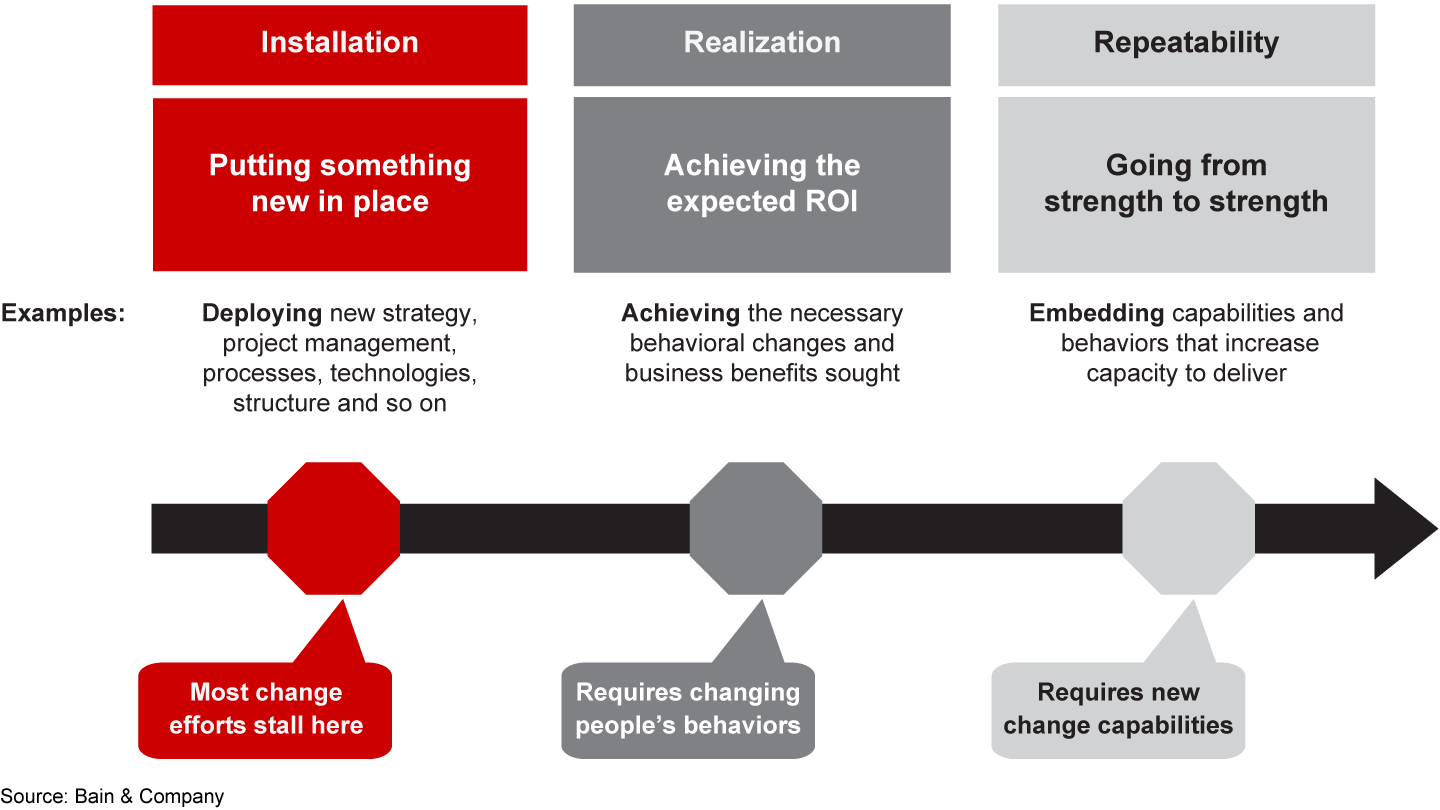
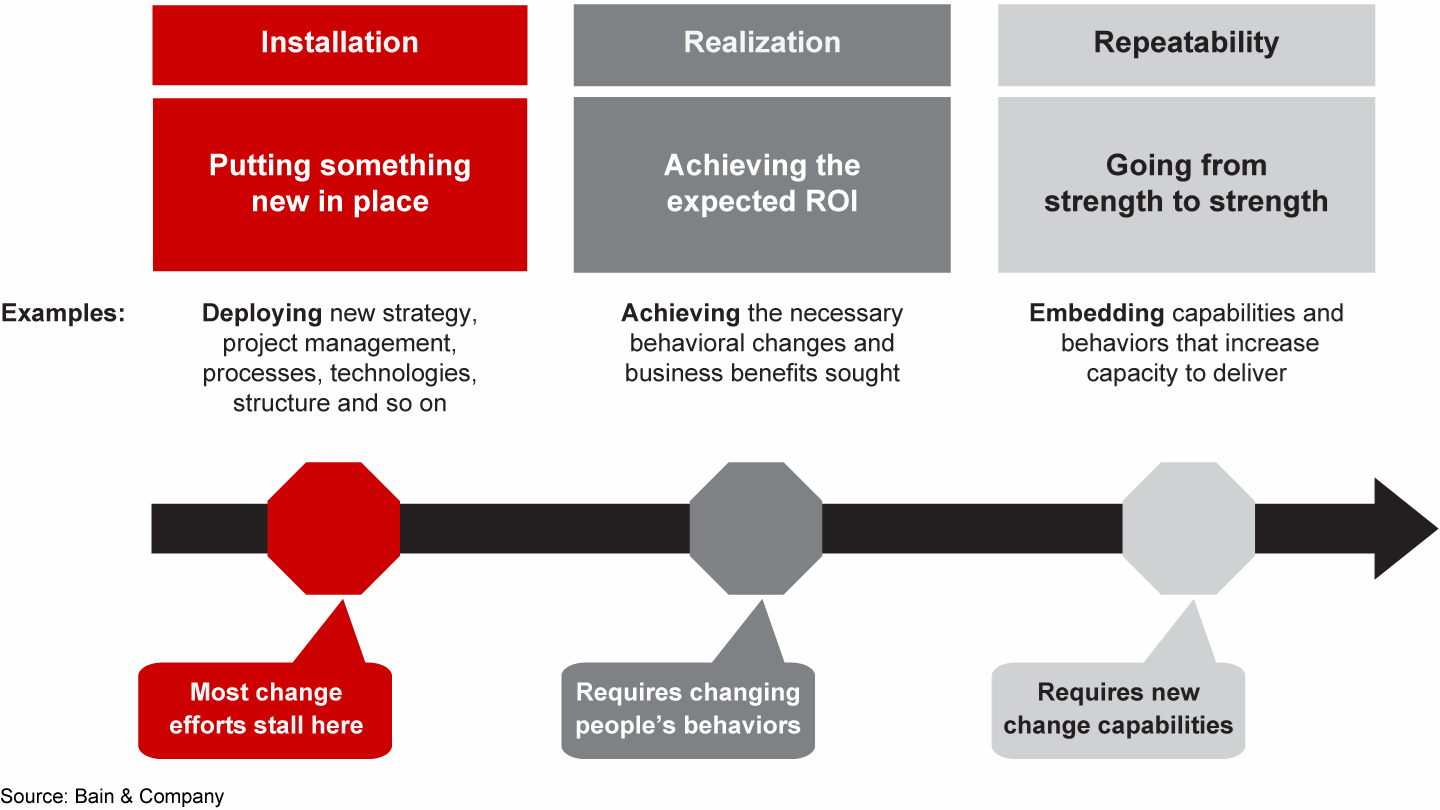
Why is it so difficult to make change take root?
To learn more about the breakdowns, we analyzed the barriers to successful change management at 184 global companies. The study enabled us to identify predictable patterns of risks in a broad cross-section of change efforts. We found, for example, that about 65% of initiatives required significant behavioral change on the part of employees—something that managers often fail to consider and plan for in advance. Nearly 60% of the companies we analyzed lacked the right capabilities to deliver on their change plans. The same percentage of companies didn’t have the appropriate individuals, structures and decision-making processes to drive the change initiatives. In addition, about 60% lacked the right metrics and incentives to make change efforts successful. And more than 63% of the companies faced high risks to their change efforts because of significant communications gaps between the leaders of the effort and the employees most affected by it.
These findings reinforce what decades of experience with clients have shown us: companies usually fall prey to three common change management myths, which lead to a superficial approach to change initiatives. Many companies assume they can get it done, for instance, with the right combination of strong incentives for their leaders, and they overlook the importance of building employee commitment during a change effort. The 12% of companies that succeed take a radically different course of action. They know that success requires leaders to learn and apply some counterintuitive strategies to change. Above all, they manage the delivery risks well (see Figure 2). Let’s take a look at each myth in turn.
Managing delivery risks is critical

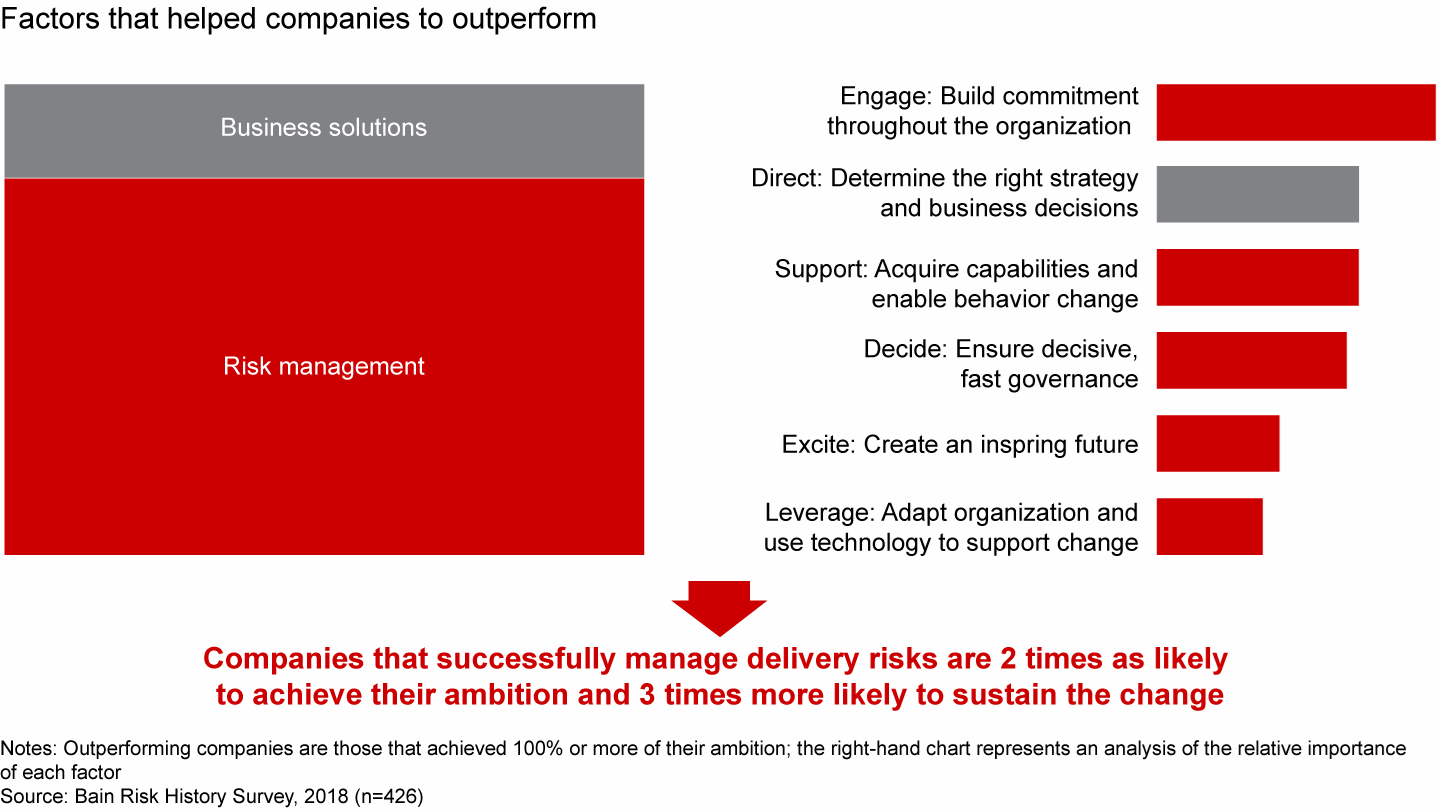
Myth #1: As long as the effect on people is minimized, change will succeed
Reality: It’s about helping people succeed despite their discomfort
Everybody knows that change starts by aligning people around a vision. But many organizations fail to win broad support, from the C-suite to the front line. The reason for that is fundamental: Change disrupts what people expect from their jobs and what many leaders don’t bother to anticipate—and plan for—the reactions of the individuals who will feel the impact the most. When people experience loss of control, many will do anything, even remain in unsatisfying situations, to try to reestablish some form of predictability. Readjusting expectations to the changed environment consumes mental, emotional and physical energy. Distracted employees cannot meet productivity and quality standards. That puts the core business at risk, and leaves people with little or no capacity to change the way they do their jobs.
Change leaders take four steps to help people succeed despite their discomfort.
- They start by identifying the employees most affected.
- They target those employees with early, effective communication that explains the reason for the change and creates a clear picture of the destination.
- They provide the dedicated leadership attention and support needed to manage the shock of change.
- They treat the leaders themselves as targets of the change.
Co-creating the ambition builds leadership support
In the earliest stage of a change effort, successful organizations ensure that the leaders who will lead the charge are on board. Workshops to cocreate the ambition help the leadership team paint a clear picture of what the change will look like when it’s finished. Senior leaders whose support and alignment are needed must be in the room when the vision takes shape. Cocreation enables them to adjust their expectations early and maintain some level of predictability even for radical change. Having taken part in the birthing process, they can brace themselves for what’s coming and start projecting how they can succeed in this new reality.
When Merck KGaA, the German healthcare company, acquired US biotech equipment supplier Millipore, one of the first moves in the post-merger integration process was a series of workshops for executives from both companies. (After a subsequent merger, the company became MilliporeSigma.) In the first workshop, participants focused on creating a vision for the combined entity. In the second, they drew up a more concrete view of the company’s future state: What would the firm look like five years down the road? In the third, they defined the initiatives required to achieve full potential. When the vision, the future state and the firm’s full potential are crafted with full participation by all members of the leadership team, the odds of success increase dramatically.
During the workshops, leaders develop a visual description that will resonate with the rest of the organization, translating it from a left-brain analytical concept to a story with emotional appeal. When a healthcare company launched a major change effort to improve customer satisfaction, it started with the hospital registration process. Gathered together in a workshop, the company’s leaders jointly developed a metaphor for the vision: hotel registration. People reserve rooms at a hotel in advance; why not apply the same model to hospital registration? A powerful metaphor helps people to visualize the change and can also drive the speed of the change management process: Project teams can make the vast majority of decisions without input from top leaders because they have a clear vision of the goal.
Myth #2: So much about change is irrational and hard to predict
Reality: The risks of change are predictable, measurable and manageable
Most companies devote too little effort to predicting how the transformation will affect the organization. The leaders of a change effort tend to focus on limiting the risks by using the tools they most know about, such as incentives. But they leave a lot on the table by not using the full range of tools available to mitigate risks. And they often fail to distinguish when to use which risk-mitigation tool.
Conduct a risk assessment to find the right mitigation tools
The fact is, every initiative has its own unique risk profile. Bain has identified over 40 specific risks that threaten to disrupt change efforts, things like poor sponsorship and change overload. These risks tend to occur with predictable patterns over the life cycle of a change. But only a few of these risks determine success or failure at each stage. At the beginning of a change initiative, for instance, if the senior sponsors aren’t aligned with a clear assessment of the organization’s ability to deliver, they can’t make an informed decision to move to the next stage.
A risk assessment enables a company to understand its risk profile and identify the four or five risks that pose the biggest threats, the sequence in which they will arise, and the tools that will be most effective for containing and managing each risk. A starting point for any risk assessment is understanding the failure modes of an organization—what it did well or poorly in executing past change initiatives. Building from there, leaders can identify the handful of risks that will be most relevant at each stage of the process for their organization, and the specific actions to mitigate them. That allows management teams to focus risk mitigation on the things that really matter.
Armed with a risk assessment, leaders can move to the next stage by creating a heat map to identify those people most affected at each stage of a change initiative and the potential trouble spots in the organization. A simple version of the heat map provided one key to the successful Merck Millipore integration. Managers drew up a two-by-two chart representing all groups in the organization across two dimensions: their importance in achieving the integration goals and the degree of likely disruption they would experience from the upcoming change. That allowed the management team to focus on supporting the people most important to the future success of the firm who faced the greatest risk of serious dislocation. The management team set about clarifying roles, helping to set priorities and providing focused change management support for the integration to succeed.
Myth #3: All you need is good leadership and day-to-day management
Reality: Disruption changes the rules of the game—and the patterns for success are often counterintuitive
When an organization experiences high levels of disruption, the management rules change. The practices and patterns that have proven effective for leading the organization break down when employees are struggling to understand what change means for them.
In high-stress situations, for example, people typically can process—hear, understand and retain—only 20% of the information they receive. Studies have shown that attention spans are compressed; in fact, full attention lasts 12 minutes or less in these conditions, instead of an hour under normal circumstances. That means the messages about important changes have to be shorter, crisper and simpler. And in situations where they must deal with change, employees want to know that you care about how it will affect them first, before they hear your message about the details of the impending change.
Trouble is, companies typically fail to treat communication during times of high stress as anything out of the ordinary. They rely on institutional channels—webcasts, newsletters, companywide emails—when people want to hear directly from those in charge. Another common mistake: management teams often use language that people cannot understand and process in times of stress—dense, jargon-filled terms. They simply don’t train their leaders in clear communication.
“High-stress” communication allows those affected by the change to hear the messages
Change leaders adjust communication methods in three ways to manage how a shaken workforce perceives the information. First, they keep the message concise, clear and brief, with a positive focus. Instead of seven points, they might boil the message down to just three key statements, and they speak for no more than 12 minutes. Second, they quickly establish themselves as trusted, credible and empathetic messengers before they even launch into their key messages. Employees typically decide within the first 30 seconds if leaders are credible and trustworthy, based on their perceived level of caring and empathy rather than expertise and competence. Third, people must hear the information from managers they trust, one on one. Initially, Merck Millipore relied primarily on an emailed newsletter and website to communicate details of its merger and pending integration, instead of arming supervisors to communicate directly with reports. When it later polled 3,900 employees on the effectiveness of its integration strategy, less than half said they understood the specifics of the change—a threat to any integration effort. The company adjusted its approach and immediately saw improvements in employee perception.
To change behavior, you need to change consequences
Effective communication is just the start. For any transformational change to succeed, people ultimately have to think and work differently. We’ve found that organizations typically spend about 90% of their effort on activities to “push” the change down the organization: designing—and then implementing—processes, training programs, organizational structures and communications that detail the new ways to work. In contrast, they invest very little effort in creating “pull” among people who are trying out new work behaviors. Researchers in the field of applied behavioral science have found that consequences such as real-time feedback loops and positive reinforcement are four times more powerful in encouraging new behavior than such activities as training programs or revised role descriptions.
One bank invested heavily in a program for cross-selling products to customers. It implemented a system for alerting bank tellers about which customers would be suitable prospects, trained tellers how to sell and compensated tellers who successfully cross-sold. But the bank lacked a plan for changing employee behavior to make the new program a success.
When a teller would apply a new script to encourage cross-selling for a qualified customer, he or she would back away if the first customers weren’t receptive. The company realized it wasn’t making progress, so it developed a thoughtful support plan. After witnessing an encounter with an impatient customer with no interest in the new product, a platform manager standing nearby would offer encouragement: “You handled that well. You weren’t defensive,” she might say. “Remember, it’s only one in five customers who will buy.” That would encourage the teller to continue applying the script, and as the teller sold the new product to more clients, the rise in performance metrics would provide further motivation. Positive reinforcement that is immediate, relevant and consistent can be significantly more effective in changing employee behavior in the early stage than the lure of longer-term rewards.
Enlist sponsors at every level with a sponsorship spine
The truth is, change depends on the effectiveness of those providing the consequences—the sponsors of the change. But sponsorship is a cascading process, and a “black hole” anywhere along the line will stop the change process below it. That’s why it’s essential to build a sponsorship spine from the bottom up. You can’t really appoint sponsors. You start by targeting the people who will need to change. Then look through their eyes one level up to the person they trust who can provide them with effective communication and meaningful consequences. That’s their sponsor. Now do it again. Look up from that sponsor to the next level up, to the person who can provide effective communication and meaningful consequences. In this way, companies can create an unbroken chain, with every level from the front line to the C-suite clear about their roles and ready to engage (see Figure 3). All sponsors in the spine need to be trained, coached and familiar with their roles.
It’s critical that companies continually monitor the health of a sponsorship spine. People quickly revert to other priorities or stop taking a change initiative seriously. That creates black holes. When sponsors are ineffective, they should be coached or, if necessary, replaced.
Build a sponsorship spine to cascade the enrollment down the organization
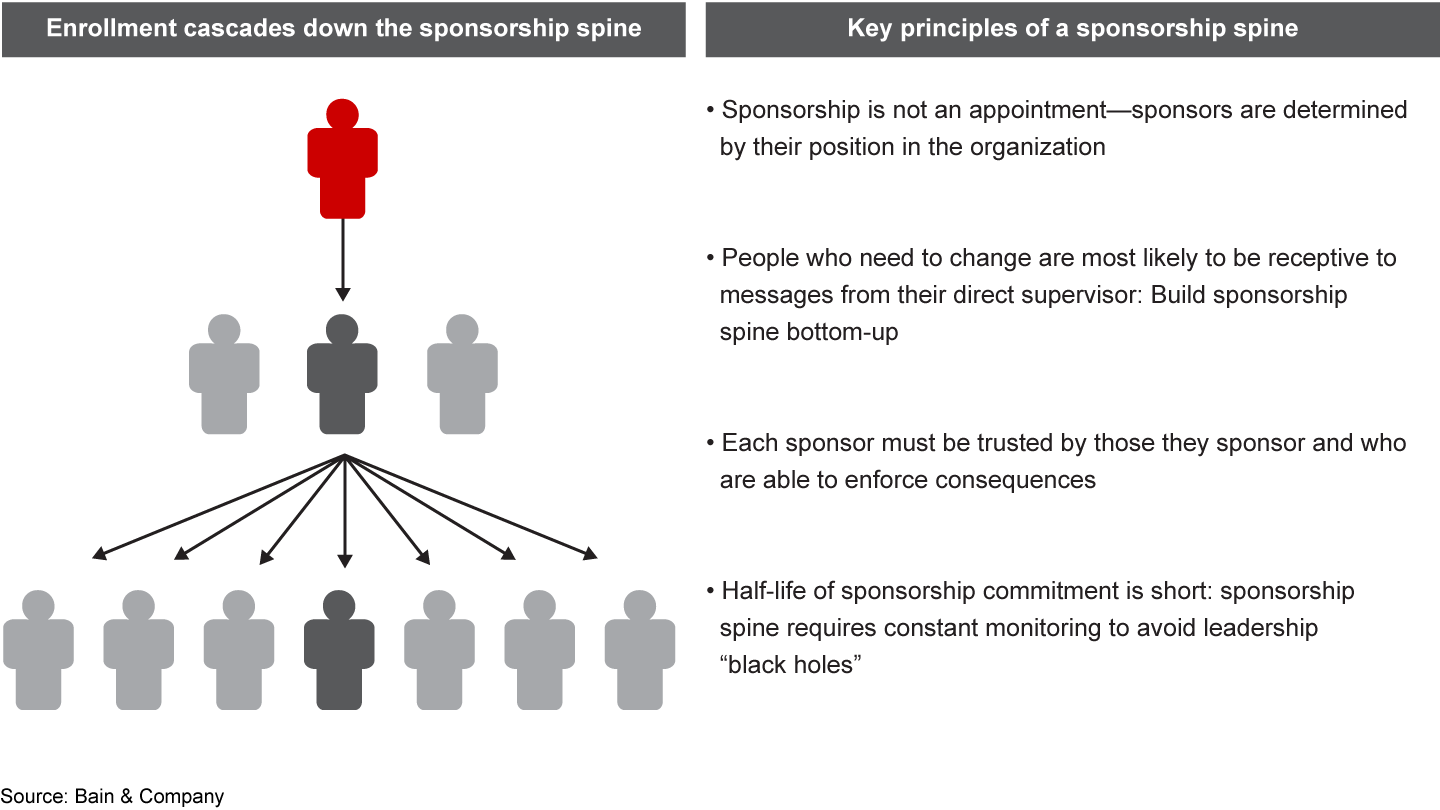
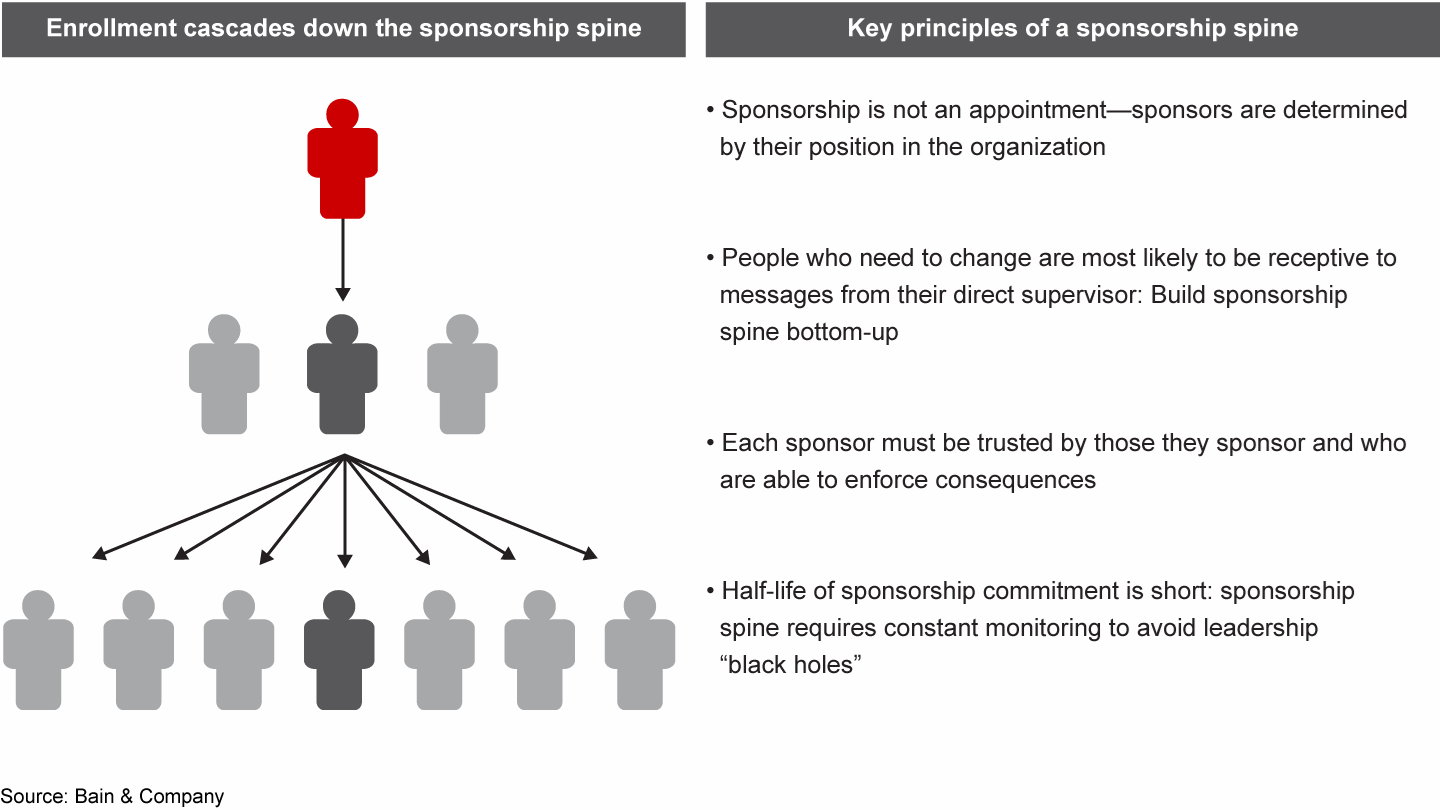
Introducing the enrollment cascade
One of the first applications of the sponsorship spine is a systematic enrollment cascade. At each level of the organization, starting with the most senior people, management holds meetings to explain how leaders reached their decisions and to ask for input in areas where it’s needed. The sponsor at each level leads the meeting, explains the change and requests feedback. Because this is done throughout the organization, it’s important to ensure that everybody is touched—and that everybody hears about it from the person who matters to them most: the person with the standing to be their sponsor, typically their direct supervisor. The enrollment cascade is the complete opposite of what typically happens when companies introduce a change effort: Everybody in the organization tunes in for a video conference in which the CEO spells out far-reaching change plans, and when they turn to their supervisor to ask for clarification, the answer comes back: “I don’t know. I just heard it at the same time as you did.”
As part of Merck Millipore’s merger integration, each supervisor hosted a series of facilitated sessions with his or her direct reports. Starting from the highest levels of the organization, sponsors explained the vision for the combined company, spelling out details of the changes occurring and answering questions. They clarified roles, established priorities and, in the case of employees from Millipore, explained Merck’s core values. Afterwards, that direct report—now a sponsor—conducted a similar one-on-one dialogue with his or her direct reports. The process repeated itself throughout the entire organization.
Change takes time, focus, determination and planning for a future where, even with the best of intentions, things are likely to veer off course. That’s why change leaders start with a clear understanding about the magnitude of the change and who will be affected. They have the discipline to conduct a thorough risk assessment, and they know how to apply the right mitigation tools at the right time. Success requires changes in behavior, and it takes courage and discipline. As anyone who has bought home gym equipment knows, the results don’t happen by themselves.
Five guiding principles of change management
How can companies move from implementation to realization and repeatability? Five guiding principles contribute to consistent and predictable results.
Help individuals succeed. Organizations don’t change, people do. To get results, individuals must behave differently. Identify the vital few behaviors that produce the most results, reinforce them consistently and invest in coaching. Develop solutions that are credible and create pull for the change.
Bring the future to life. Create a clear and compelling story about the future to ensure leaders are aligned and committed to enroll the entire organization. Develop leadership talent and ensure leaders work effectively together.
Inspire deep commitment. Build a healthy sponsorship spine and develop a process to cascade commitment along the spine to the front line and activate key influencers. Shift communication to a two-way dialogue.
Deliver the value. Develop a realistic transformation plan based on the organization’s capacity to absorb change. Establish a governance structure to ensure effective, efficient decision-making. Measure progress based on goals attained, not just on installing the change program.
Build to sustain. Modify roles, structure and culture, and adapt information technology systems to support the change. Establish feedback loops and response mechanisms that allow solutions to evolve as needed.
The good news is that risks are predictable and measurable: Anticipate the risks and focus on actions that reduce them at each phase of the change.
Patrick Litré is a partner with Bain & Company in Atlanta and global leader of the firm’s Results Delivery® practice. David Michels is a partner in Bain’s Zürich office and leader of the Results Delivery practice in Europe, the Middle East and Africa. Ivan Hindshaw is a partner in the firm’s Los Angeles office and leads the Results Delivery practice in the Americas. Parijat Ghosh is a partner in the New Delhi office and leads the Results Delivery practice in the Asia-Pacific region.
Results Delivery® is a registered trademark of Bain & Company Inc.